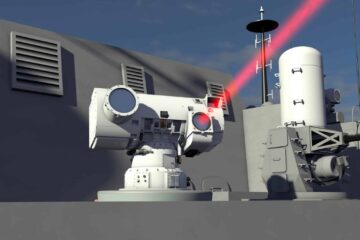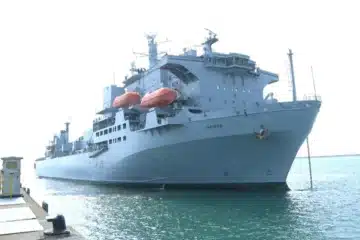The proof of concept demonstration, to be conducted off the US eastern seaboard, is intended to inform a Future Maritime Aviation Force (FMAF) workstrand investigating a large carrier-compatible fixed-wing UAS for persistent wide-area surveillance/airborne early warning (AEW).
Building on the avionics and flight control systems of the GA-ASI MQ-9B UAS family, the Mojave air vehicle features enlarged wings with high-lift devices, a ruggedised undercarriage, and a 450 hp turboprop engine. A prototype began flight testing in mid-2021.
A transparency notice was published by the Ministry of Defence (MoD) on 19 May advising its intention to contract with General Atomics for a STOL threshold capability demonstration. According to the MoD, the seven-month programme – valued at up to GBP1.5 million – will conduct experiments “that will determine the future scope to address a number of capability problem sets and will support future investment decisions”.
Although the contract has yet to be placed, planning for the trials activity is already well developed, according to Bob Schoeffling, GA-ASI’s VP international strategic development. Speaking to at the CNE 2023 conference in Farnborough, UK, on 24 May, he said that the company “is in discussion with the Royal Navy to do a proof-of-concept launch and possible recovery of [Mojave] later this year”. The RN has subsequently confirmed that the trial is planned for November 2023.
The STOL performance offered by the Mojave means it can take off unassisted off the angle of the flight deck on Prince of Wales. The air vehicle is also capable of recovering without arrestor gear, although the absence of a Joint Precision Approach Landing System fit may mean that it is limited to offset approaches only at this stage.

Although the Mojave STOL UAS was originally conceived for austere short-field operations on land, GA-ASI is now seeing increasing interest from navies interested in a STOL adaptation of the MQ-9B SeaGuardian enabled by a wing and tail kit that can be installed in less than one day. Schoeffling told the CNE 2023 audience that the company has already undertaken concept development and engineering studies to explore how the MQ-9B could contribute to both long-range anti-submarine warfare and AEW: in the latter case, GA-ASI has worked with an unnamed radar house to explore a twin radar pod mission kit.

The RN’s FMAF programme is exploring options for a range of aviation roles to be transitioned to ‘uncrewed’ and autonomous platforms over the next decade. As part of this, the Vixen strand is examining a carrier-based multi-role capability able to perform the AEW mission, or carry other modular payloads up to around 500 kg.






